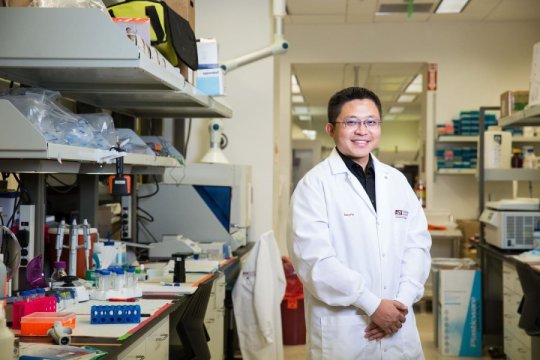
Summary:Researchers describe the development of several new methods for TB diagnosis that improve the speed, accuracy, and cost of TB detection.
Skeletal remains dating to the Neolithic era in Egypt bear tell-tale traces of tuberculosis (TB) — a disease that is estimated to have killed a billion people in the last two centuries alone.
The bacteria responsible for TB can lurk in a person’s lung tissue for decades before producing active, infectious TB disease and it is estimated that a third of the global population may have such dormant infections, with 5 percent to 10 percent progressing to active disease. Detecting TB is notoriously challenging.
In a series of new studies, Tony Hu, a researcher at Arizona State University’s Biodesign Institute, describes the development of several new methods for TB diagnosis that improve the speed, accuracy, and cost of TB detection. They should also dramatically improve TB treatment.
TB remains among the top 10 causes of death world-wide, and was responsible 1.8 million deaths in 2015 alone. Rapid and accurate TB diagnosis is critical both for patient care and to prevent TB transmission. “There are over 10 million new cases of tuberculosis each year,” Hu says, adding that “one third of them cannot be diagnosed using any available technology.”
While tuberculosis can be cured, this requires that patients adhere to a strict drug regimen for months, despite common side effects, and multi-drug resistant TB bacteria are becoming more common. Current diagnostic methods can take a long time and poorly detect TB in certain types of patients, including children and patients with HIV infections, making it difficult to determine who needs to be treated and when they have been cured of disease.
New approaches for improved TB detection
One of the new methods described addresses these issues by measuring proteins that TB bacteria release into the bloodstream during active infections. Hu’s group has applied this approach to detect patients with all forms of TB disease, including patients co-infected with HIV, many of whom cannot be diagnosed by common methods like bacterial culture.
Speed, cost and the sample type required are also major issues in resource-limited settings where TB is often more common. For this reason, Hu’s group has developed an inexpensive nanotechnology approach to detect another factor released into the blood in patients with active TB disease. This method requires very little equipment or supplies and is read by a mobile phone.
These TB assays address the critical need for rapid, accurate TB tests as outlined by the World Health Organization’s 2016 TB report and should have broad use for detecting active TB cases and monitoring their response to treatment.
An elusive enemy
Standard TB tests suffer from a number of serious shortcomings that limit their usefulness, particularly in areas where medical resources are scarce. For example, skin tests for TB reactivity can detect if an individual has been infected by TB, but not whether the infection still present or whether it is active or dormant.
Bacterial culture is the gold standard for TB diagnosis, but often requires 4 to 6 weeks to achieve a final result, and it and other TB detection methods can fail when TB bacteria are not present at high concentration within a sample. Respiratory tract mucus (sputum) is usually used for these analyses since TB is an airborne infection, but invasive procedures may be required to obtain specimens for culture if the patient cannot produce enough sputum or if it is suspected that the infection has escaped the lungs.
Dr. Hu and his colleagues have applied nanotechnology-based approaches to detect TB proteins in patient blood samples to improve disease detection. Unlike existing methods that attempt to identify bacteria or bacterial DNA in sputum or tissue samples, his two methods measure TB-derived factors released into the blood only during active TB infections and provide a measure of the number of active TB bacteria in the patient.
In the most sensitive and high-tech version of these two TB assays, Hu’s group used porous silica nanodisks adorned with antibodies to the TB proteins CFP-10 and ESAT-6 and performed a proof-of-concept study to prove that this method could identify patients with TB infections within or outside of their lungs, regardless of their TB culture results or HIV co-infection status.
Double trouble: TB and HIV
The ability to detect TB and HIV co-infected patients, who often have negative sputum TB culture results, is critical due to the high global rate of HIV-TB co-infection and its lethal consequences. Studies indicate that 35 percent of HIV patients in the US die of TB infections, and this mortality rate is even higher in Africa and South Asia, where 75 percent of HIV patients die from TB infections.
HIV-positive patients are also 20-30 times more vulnerable to TB infection than individuals who are HIV-negative, while TB patients are more susceptible to HIV infection. TB symptoms can resemble other complications of HIV, and standard TB tests are less sensitive when used to test HIV-infected patients, so that HIV-positive patients often have undiagnosed TB cases.
The study for BMC Medicine examined HIV-positive adults enrolled in the Houston Tuberculosis Initiative, a large TB screening and surveillance study which ran from October 1995 to September 2004. By measuring the TB protein CPF-10 in the blood of HIV-infected subjects, his group detected 85 percent of all TB cases and 67 percent of culture-negative TB cases, much better than the best available molecular test, which is reported to detect only 9 percent of culture-negative TB cases in HIV-infected patients.
More: Science Daily



Leave a Reply
You must be logged in to post a comment.